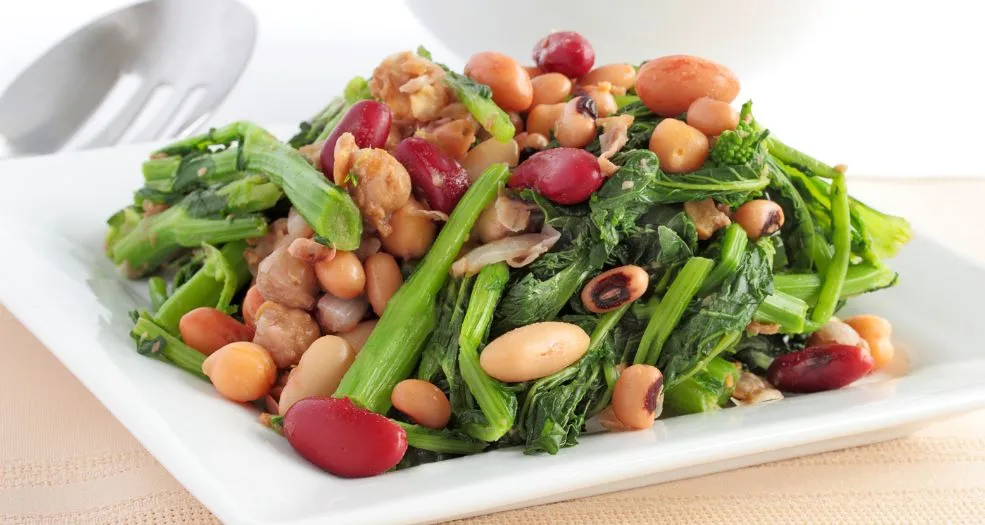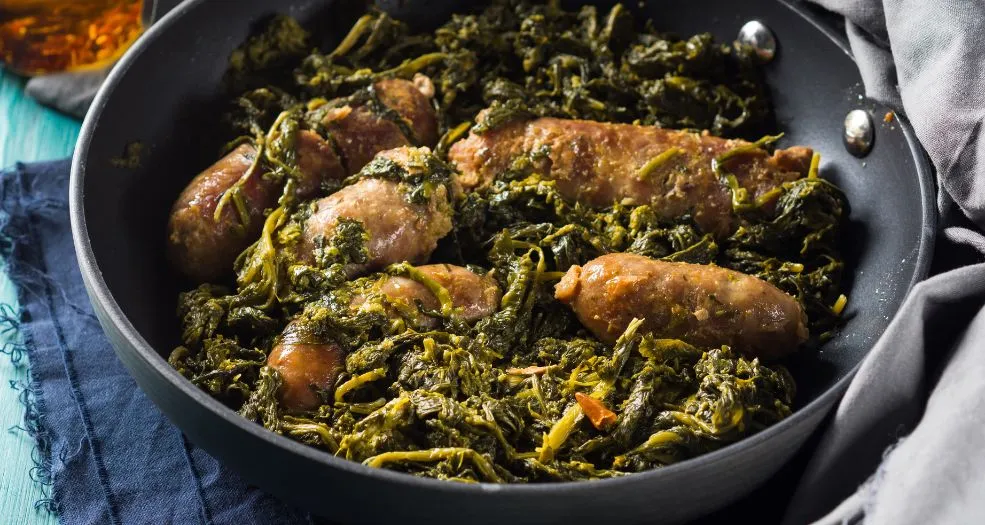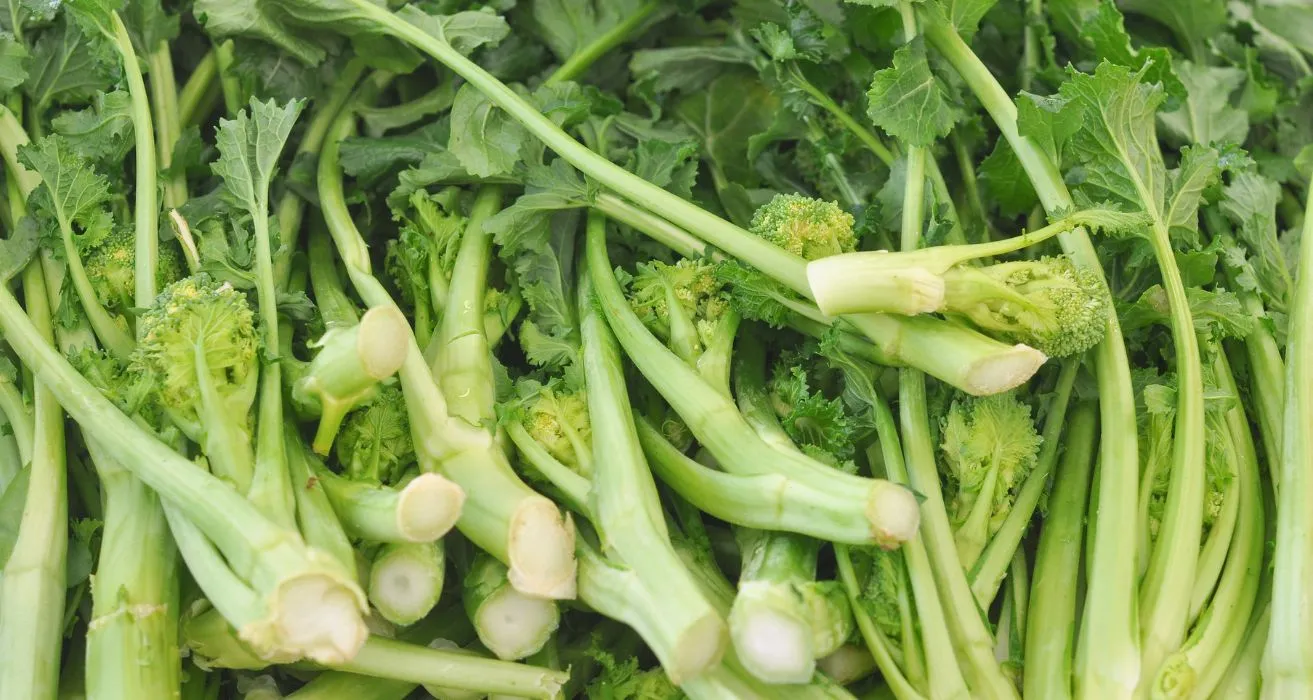Rapini, often known as broccoli rabe, is a hidden gem in the world of leafy greens. Not only is it packed with nutrients, but it also brings a unique, slightly bitter taste that can transform any dish. Whether you’re a seasoned chef or a curious foodie, understanding and incorporating rapini into your meals can open up a new dimension of flavors. This article is your ultimate guide to everything rapini. From selecting the freshest bunch to cooking it to perfection, we’ll explore the ins and outs of this versatile vegetable. So, let’s dive in and unlock the full potential of this ingredint in your kitchen.
Introduction
Understanding Rapini (Broccoli Rabe)
At first glance, rapini might look like an ordinary green vegetable, but its taste and nutritional value set it apart. Unlike its name suggests, it is closer to turnips than to broccoli. This connection to root vegetables contributes to its slightly bitter taste, a characteristic that, when cooked correctly, adds depth and complexity to meals.
This vegetable is a staple in Italian cuisine, celebrated for its adaptability and its ability to pair wonderfully with garlic, olive oil, and a hint of chili pepper. However, its appeal doesn’t stop at the borders of Italy. Around the globe, chefs and home cooks alike are discovering the potential of this ingredient to transform their dishes.
The Nutritional Profile of Rapini
This vegetable is a powerhouse of vitamins and minerals. Rich in vitamins A, C, and K, it supports vision health, immune function, and bone health, respectively. Additionally, it offers a good dose of calcium for strong bones and iron for healthy blood cells. Its nutritional profile is complemented by dietary fiber, essential for digestive health. Including it in your diet means you’re not just adding flavor to your meals; you’re also boosting your intake of crucial nutrients.
Culinary Uses and Popularity
The beauty of rapini lies in its culinary flexibility. Whether blanched and sautéed with a splash of olive oil and garlic or mixed into pasta for a green twist, rapini brings a vibrant, earthy component to dishes. Its slightly peppery taste makes it a perfect side for rich, savory meats and a standout ingredient in vegetarian dishes. Beyond traditional Italian recipes, it is making its way into salads, stir-fries, and even on top of pizzas, showcasing its versatility.
In conclusion, this ingredient is more than just a vegetable; it’s a journey into a world of rich flavors and nutritional benefits. As we delve deeper into how to select, prepare, and cook rapini, you’ll discover the many ways this green can enrich your cooking and your health. Let’s embrace the vibrant world of rapini together, exploring its possibilities one recipe at a time
Selecting and Preparing Rapini
When it comes to cooking with rapini, also known as broccoli rabe, the journey begins long before you turn on your stove. The key to unlocking the full potential of this leafy green starts with selecting the freshest produce and preparing it correctly. Follow these insights to set the foundation for a myriad of flavorful dishes.
Choosing Fresh Rapini
Selecting fresh rapini is the first step toward creating a memorable dish. This vibrant green vegetable should boast lush, dark leaves and firm stalks. A fresh bunch will not only look appealing but will also have a less pronounced bitterness, which is characteristic of older, more mature plants.
Where to Find Rapini
Depending on where you live, finding rapini can be an adventure in itself. In areas with a significant Italian population, it might be as common as any other vegetable. However, in other regions, you may need to visit specialty stores or farmers’ markets. Don’t hesitate to ask your local grocer to stock it, as rapini’s popularity is on the rise.
Signs of Freshness
A fresh bunch of rapini should have crisp, green leaves and stalks. Avoid any bunches that show signs of yellowing or wilting, as these are indicators of age. The florets should be tightly closed, resembling small broccoli heads, without any signs of flowering. Fresh rapini should feel firm to the touch, indicating it’s ready to be transformed into a delicious dish.
Preparing Rapini for Cooking
Once you’ve selected the perfect bunch of rapini, preparing it correctly is crucial for the best culinary results. This process enhances its natural flavors and ensures a pleasant texture in every bite.
Cleaning and Trimming
Begin by rinsing the rapini under cold running water to remove any dirt or debris caught in the leaves. Shake off the excess water, and then pat dry with a clean kitchen towel. Next, trim the bottom of the stalks, removing about an inch. This part tends to be more fibrous and tough, detracting from the overall texture of your dish.
The Importance of Blanching
Blanching rapini is a simple yet effective technique to mitigate its natural bitterness. To blanch, bring a large pot of salted water to a boil. Add the rapini and cook for about one to two minutes, just enough to brighten its color and soften the stalks slightly. Immediately transfer the rapini to a bowl of ice water to halt the cooking process. This step not only preserves the vibrant green color but also maintains the rapini’s crisp-tender texture, making it a delightful addition to any recipe.
Blanched rapini is now ready to be sautéed, incorporated into pasta dishes, or served as a nutritious side. By selecting the freshest produce and preparing it with care, you ensure that the rapini’s natural flavors and nutritional benefits are preserved, setting the stage for an array of delicious and healthy meals. Stay tuned for more tips on how to cook and pair it to bring out its best in your culinary creations
Cooking with Rapini
Basic Cooking Techniques:
Cooking this ingredient is both an art and a science. Let’s start with a simple yet sublime method: sautéing.

Sautéing Rapini with Garlic and Olive Oil
Ingredients:
- 1 bunch of rapini (broccoli rabe), about 1 pound
- 3 tablespoons extra virgin olive oil
- 3 cloves of garlic, thinly sliced
- ¼ teaspoon red pepper flakes (optional)
- Salt and pepper to taste
Directions:
- After blanching, heat the olive oil in a large skillet over medium heat.
- Add the garlic slices and cook until fragrant, about 1 minute. Be careful not to burn them.
- Stir in the blanched rapini and red pepper flakes. Season with salt and pepper.
- Cook, stirring occasionally, for 3 to 5 minutes, or until the it is crisp-tender.
- Serve warm as a delightful side dish or over pasta for a simple, nutritious meal.
Incorporating Rapini into Italian Dishes
Rapini’s bold flavor pairs beautifully with hearty Italian dishes. Think of it as a side to lasagna or a robust addition to a rustic white bean soup. For a touch of inspiration, explore the Italian Marinated Green Bean Salad. It’s a testament to the harmony of Italian flavors and the perfect complement to your rapini creations.
Advanced Recipes
Ready to level up? Let’s dive into a couple of recipes that showcase rapini’s versatility.
Rapini and Provolone Hoagie
A vegetarian delight that doesn’t skimp on flavor. Sauté rapini as above, layer it with sharp provolone on a crusty hoagie roll, and you’ve got a sandwich that’ll make anyone a rapini believer.
Lemon Rapini Pasta
Ingredients:
- 1 bunch of rapini, prepared as above
- 8 ounces of your favorite pasta
- Zest and juice of 1 lemon
- 2 tablespoons extra virgin olive oil
- Parmesan cheese, for serving
Directions:
- Cook the pasta according to package instructions. Drain, reserving a cup of the pasta water.
- In the same pan, heat the olive oil and add the prepared rapini, lemon zest, and juice.
- Toss the pasta back in, adding a splash of pasta water to create a light sauce.
- Serve with a generous sprinkle of Parmesan cheese.
Lemon Rapini Pasta with Toasted Breadcrumbs
This pasta dish balances the bitterness of rapini with the brightness of lemon, topped with a crispy breadcrumb texture.
Ingredients:
- 1 bunch rapini, prepared as instructed
- 8 ounces pasta (linguine or spaghetti works well)
- Zest and juice of 1 lemon
- 3 tablespoons olive oil, divided
- 3 cloves garlic, minced
- 1/2 cup breadcrumbs
- 1/4 cup grated Parmesan cheese
- Salt and pepper to taste
Directions:
- Cook pasta according to package instructions in salted water until al dente. Reserve 1 cup of pasta water, then drain and set aside.
- While the pasta is cooking, heat 1 tablespoon of olive oil in a skillet over medium heat. Add breadcrumbs and toast, stirring frequently until golden and crispy, about 3-5 minutes. Transfer to a bowl and set aside.
- In the same skillet, heat the remaining olive oil over medium heat. Add garlic and cook until fragrant, about 1 minute.
- Add the prepared rapini to the skillet. Cook, stirring occasionally, until heated through, about 3-4 minutes. Stir in lemon zest and juice, and season with salt and pepper.
- Add the drained pasta to the skillet with the mixture. Toss well to combine, adding a little reserved pasta water if needed to loosen the sauce.
- Serve the pasta sprinkled with toasted breadcrumbs and grated Parmesan cheese.
These advanced recipes not only highlight the versatility of rapini but also offer a delightful exploration of flavors and textures. Whether you’re crafting a hearty sandwich or a refreshing pasta dish, rapini can elevate your culinary creations to new heights
Nutritional and Health Benefits
Rapini, also known as broccoli rabe, is more than just a versatile green for culinary use; it’s a nutritional powerhouse that offers a plethora of health benefits. Packed with vitamins, minerals, and antioxidants, rapini is an excellent addition to any diet. Understanding these benefits can help individuals make informed choices about incorporating this vegetable into their meals.

Rich in Essential Vitamins and Minerals
This vegetable is loaded with vitamins A, C, and K, which play crucial roles in maintaining good health. Vitamin A supports eye health and immune function, vitamin C is a powerful antioxidant that helps protect the body against free radicals, and vitamin K is essential for bone health and wound healing. Additionally, rapini provides a good source of iron, which is vital for forming red blood cells, and calcium, necessary for bone health and muscle function.
High in Antioxidants
Antioxidants are compounds that help fight oxidative stress caused by free radicals, which are unstable molecules that can damage cells. Rapini is rich in antioxidants, including beta-carotene, quercetin, and sulforaphane. These compounds have been linked to a reduced risk of chronic diseases, such as heart disease and cancer, by neutralizing harmful free radicals.
Supports Digestive Health
Rapini is a good source of dietary fiber, which is beneficial for digestive health. Fiber helps to keep the digestive system running smoothly by supporting regular bowel movements and preventing constipation. It can also help to maintain a healthy gut microbiome, which is essential for overall health.
Anti-inflammatory Properties
The antioxidants and other phytochemicals found in rapini have anti-inflammatory properties. Chronic inflammation is a root cause of many diseases, including arthritis, heart disease, and certain cancers. By including anti-inflammatory foods like rapini in your diet, you can help reduce inflammation and protect against these conditions.
Enhances Detoxification
Glucosinolates found in rapini can help support the body’s detoxification processes. These compounds are broken down into isothiocyanates in the body, which have been shown to aid in detoxifying certain carcinogens and protect cells from DNA damage.
Incorporating rapini into your diet is not only a way to enhance the flavor of your dishes but also to boost your intake of essential nutrients and compounds that support health and well-being. Whether you’re looking to improve your digestive health, reduce inflammation, or simply add more nutrients to your diet, it is a versatile and healthful choice
FAQs
What is rapini called in Australia?
In Australia, it is commonly referred to as broccoli raab or raab. Interestingly, it’s also known as rapa or rapine in some regions, showcasing the diverse culinary influences across the country.
What is rapini called in the UK?
In the UK, it goes by the name of broccoli raab or Italian turnip. This reflects the vegetable’s European roots and its popularity in Italian cuisine.
What is rapini called in India?
In India, it might not be widely recognized under a specific name but is often referred to as saag by those familiar with it, especially in communities that appreciate its similarity to other leafy greens used in Indian cuisine.
What is another name for rapini?
it is also widely known as broccoli raab, broccoli rabe, or simply raab. These names highlight the vegetable’s close relation to broccoli, despite its distinct taste and appearance.
What is rapini called in Italy?
In Italy, it is traditionally called cime di rapa or broccoletti di rapa, terms that reflect its culinary significance and frequent use in Southern Italian dishes.
What nationality is rapini?
This vegetable is of Italian origin, particularly from the Mediterranean region. It has been a staple in Italian cuisine for centuries, especially in the southern parts of the country.
Why is rapini so bitter?
Rapini’s bitterness is a natural characteristic of the vegetable, attributed to its compounds called glucosinolates. These compounds, while contributing to its distinct taste, also offer numerous health benefits.
What is broccoli di rapa in English?
In English, broccoli di rapa is commonly referred to as broccoli raab or rapini. This name change helps to bridge the cultural gap, bringing a piece of Italian culinary tradition to the English-speaking world.
What is rapini in Chinese?
In Chinese, rapini is known as 芥蓝 (jiè lán), which directly translates to mustard greens. This reflects the vegetable’s slightly bitter taste and its green, leafy appearance, similar to other greens used in Chinese cuisine.
What is rapini leaves in English?
Rapini leaves, in English, are simply part of what is collectively known as broccoli raab. These leaves are an integral part of the vegetable, enjoyed for their slightly bitter taste.
Is rapini baby broccoli?
No, rapini is not baby broccoli. Despite its similar appearance to broccoli’s florets, rapini is a distinct vegetable with its own unique taste and texture, characterized by its leafy greens and small, bud-like florets.
How to Reduce Bitterness in Rapini
The key to mellowing rapini’s natural bitterness lies in blanching. A quick boil for 60 to 90 seconds does wonders. Immediately plunging it into ice water afterward stops the cooking process, preserving its vibrant color and crispness.
Edible Parts of Rapini
Wondering what parts of rapini you can eat? All of it! From the leafy greens to the stalks and florets, each part offers a unique texture and taste. Just remember to trim the very bottom of the stalks, as they can be woody.
Storing and Reheating Tips
To keep rapini fresh, store it in a plastic bag in the refrigerator’s crisper drawer. It should stay crisp for up to a week. When it comes to reheating, a quick stint in the microwave or a brief sauté will bring it back to life. Just be careful not to overcook it, as this can make it mushy.
Enhancing Your Rapini Dishes
Knowing how to cook rapini is one thing, but understanding what to pair it with elevates your culinary game. Let’s explore some pairing ideas that complement rapini’s unique flavor profile.
Ideal Pairings for Rapini
Rapini’s slight bitterness pairs wonderfully with rich, savory flavors. Consider serving it alongside dishes with a hearty base, such as roasted meats or creamy pasta. The boldness of this vegetable cuts through the richness, offering a refreshing balance.
Serving Suggestions
For a truly harmonious meal, try rapini with Italian classics. It’s a natural fit for spaghetti and meatballs, lasagna, or baked ziti. For a lighter option, pair it with a White Beans and Escarole recipe. The mild beans and slightly bitter escarole create a delightful contrast to the rapini.
Remember, the key to a successful dish lies in balance. Rapini should complement, not overpower, your main. With these pairing tips, you’re ready to create meals that showcase rapini’s versatility and depth of flavor.
Conclusion
As we wrap up our comprehensive journey through the world of rapini, it’s clear that this leafy green is more than just a side dish. It’s a versatile, nutritious ingredient that can elevate your cooking. From its nutritional benefits to its bold flavor, it deserves a spot in your kitchen repertoire.
Encouragement to Experiment
We encourage you to experiment with rapini in your cooking. Its versatility means it can adapt to a wide range of cuisines and dishes. Don’t be afraid to pair it with different flavors and ingredients. The more you cook with it, the more you’ll appreciate its unique qualities.
As you continue to explore the culinary world, remember that the best dishes come from a place of creativity and curiosity. Rapini, with its rich flavor and nutritional profile, is a fantastic ingredient to inspire your culinary adventures.
